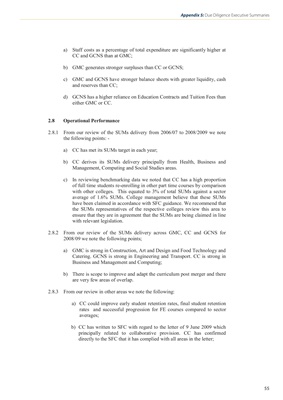
a) Staff costs as a percentage of total expenditure are significantly higher at
CC and GCNS than at GMC;
b) GMC generates stronger surpluses than CC or GCNS;
c) GMC and GCNS have stronger balance sheets with greater liquidity, cash
and reserves than CC;
d) GCNS has a higher reliance on Education Contracts and Tuition Fees than
either GMC or CC.
2.8 Operational Performance
2.8.1 From our review of the SUMs delivery from 2006/07 to 2008/2009 we note
the following points: -
a) CC has met its SUMs target in each year;
b) CC derives its SUMs delivery principally from Health, Business and
Management, Computing and Social Studies areas.
c) In reviewing benchmarking data we noted that CC has a high proportion
of full time students re-enrolling in other part time courses by comparison
with other colleges. This equated to 3% of total SUMs against a sector
average of 1.6% SUMs. College management believe that these SUMs
have been claimed in accordance with SFC guidance. We recommend that
the SUMs representatives of the respective colleges review this area to
ensure that they are in agreement that the SUMs are being claimed in line
with relevant legislation.
2.8.2 From our review of the SUMs delivery across GMC, CC and GCNS for
2008/09 we note the following points;
a) GMC is strong in Construction, Art and Design and Food Technology and
Catering. GCNS is strong in Engineering and Transport. CC is strong in
Business and Management and Computing;
b) There is scope to improve and adapt the curriculum post merger and there
are very few areas of overlap.
2.8.3 From our review in other areas we note the following:
a) CC could improve early student retention rates, final student retention
rates and successful progression for FE courses compared to sector
averages;
b) CC has written to SFC with regard to the letter of 9 June 2009 which
principally related to collaborative provision. CC has confirmed
directly to the SFC that it has complied with all areas in the letter;
55
Appendix 5: Due Diligence Executive Summaries